Exploring Effective Chemical Indicators for Petrochemical Emissions with Network Measurements Coupled with Model Simulations
Abstract
1. Introduction
2. Methods
2.1. Monitoring Facilities
2.2. Wind Characteristics in the Petro–Region
2.3. Model Setup
3. Results and Discussion
3.1. Validation of NMHC Observations
3.2. Ratios of P/A and E/A as Petro–Emission Indicators
3.3. SO2 and NOx with Modeling to Indicate Stack Plumes
3.4. Test of SO2 and NOX as Petro–Emission Indicators
4. Conclusions
Supplementary Materials
Author Contributions
Funding
Acknowledgments
Conflicts of Interest
References
- Baltrėnas, P.; Baltrėnaitė, E.; Šerevičienė, V.; Pereira, P. Atmospheric BTEX concentrations in the vicinity of the crude oil refinery of the Baltic region. Environ. Monit. Assess. 2011, 182, 115–127. [Google Scholar] [CrossRef]
- Nadal, M.; Schuhmacher, M.; Domingo, J.L. Long—Term environmental monitoring of persistent organic pollutants and metals in a chemical/petrochemical area: Human health risks. Environ. Pollut. 2011, 159, 1769–1777. [Google Scholar] [CrossRef]
- Mo, Z.; Shao, M.; Lu, S.; Qu, H.; Zhou, M.; Sun, J.; Gou, B. Process–specific emission characteristics of volatile organic compounds (VOCs) from petrochemical facilities in the Yangtze River Delta, China. Sci. Total Environ. 2015, 533, 422–431. [Google Scholar] [CrossRef]
- Kampeerawipakorn, O.; Navasumrit, P.; Settachan, D.; Promvijit, J.; Hunsonti, P.; Parnlob, V.; Nakngam, N.; Choonvisase, S.; Chotikapukana, P.; Chanchaeamsai, S.; et al. Health risk evaluation in a population exposed to chemical releases from a petrochemical complex in Thailand. Environ. Res. 2017, 152, 207–213. [Google Scholar] [CrossRef]
- Hsu, C.-Y.; Chiang, H.-C.; Shie, R.-H.; Ku, C.-H.; Lin, T.-Y.; Chen, M.-J.; Chen, N.-T.; Chen, Y.-C. Ambient VOCs in residential areas near a large—Scale petrochemical complex: Spatiotemporal variation, source apportionment and health risk. Environ. Pollut. 2018, 240, 95–104. [Google Scholar] [CrossRef]
- Cetin, E.; Odabasi, M.; Seyfioglu, R. Ambient volatile organic compound (VOC) concentrations around a petrochemical complex and a petroleum refinery. Sci. Total Environ. 2003, 312, 103–112. [Google Scholar] [CrossRef]
- Tiwari, V.; Hanai, Y.; Masunaga, S. Ambient levels of volatile organic compounds in the vicinity of petrochemical industrial area of Yokohama, Japan. Air Qual. Atmos. Health 2010, 3, 65–75. [Google Scholar] [CrossRef]
- Huang, Y.S.; Hsieh, C.C. Ambient volatile organic compound presence in the highly urbanized city: Source apportionment and emission position. Atmos. Environ. 2019, 206, 45–59. [Google Scholar] [CrossRef]
- Zhang, Z.; Wang, H.; Chen, D.; Li, Q.; Thai, P.; Gong, D.; Li, Y.; Zhang, C.; Gu, Y.; Zhou, L.; et al. Emission characteristics of volatile organic compounds and their secondary organic aerosol formation potentials from a petroleum refinery in Pearl River Delta, China. Sci. Total Environ. 2017, 584–585, 1162–1174. [Google Scholar] [CrossRef]
- Hu, B.; Xu, H.; Deng, J.; Yi, Z.; Chen, J.; Xu, L.; Hong, Z.; Chen, X.; Hong, Y. Characteristics and Source Apportionment of Volatile Organic Compounds for Different Functional Zones in a Coastal City of Southeast China. Aerosol Air Qual. Res. 2018, 18, 2840–2852. [Google Scholar] [CrossRef]
- Gu, Y.; Li, Q.; Wei, D.; Gao, L.; Tan, L.; Su, G.; Liu, G.; Liu, W.; Li, C.; Wang, Q. Emission characteristics of 99 NMVOCs in different seasonal days and the relationship with air quality parameters in Beijing, China. Ecotoxicol. Environ. Saf. 2019, 169, 797–806. [Google Scholar] [CrossRef] [PubMed]
- Carter, W.P.L. A detailed mechanism for the gas–phase atmospheric reactions of organic compounds. Atmos. Environ. Part A Gen. Top. 1990, 24, 481–518. [Google Scholar] [CrossRef]
- Carter, W.P.L. Development of Ozone Reactivity Scales for Volatile Organic Compounds. Air Waste 1994, 44, 881–899. [Google Scholar] [CrossRef]
- Seinfeld, J.H.; Pandis, S.N. Atmospheric Chemistry and Physics; Wiley: New York, NY, USA, 1998. [Google Scholar]
- Atkinson, R.; Arey, J. Atmospheric Degradation of Volatile Organic Compounds. Chem. Rev. 2003, 103, 4605–4638. [Google Scholar] [CrossRef]
- Hui, L.; Liu, X.; Tan, Q.; Feng, M.; An, J.; Qu, Y.; Zhang, Y.; Deng, Y.; Zhai, R.; Wang, Z. VOC characteristics, chemical reactivity and sources in urban Wuhan, central China. Atmos. Environ. 2020, 224, 117340. [Google Scholar] [CrossRef]
- Huang, R.-J.; Zhang, Y.; Bozzetti, C.; Ho, K.-F.; Cao, J.-J.; Han, Y.; Daellenbach, K.R.; Slowik, J.G.; Platt, S.M.; Canonaco, F.; et al. High secondary aerosol contribution to particulate pollution during haze events in China. Nature 2014, 514, 218–222. [Google Scholar] [CrossRef]
- Yao, L.; Garmash, O.; Bianchi, F.; Zheng, J.; Yan, C.; Kontkanen, J.; Junninen, H.; Mazon, S.B.; Ehn, M.; Paasonen, P.; et al. Atmospheric new particle formation from sulfuric acid and amines in a Chinese megacity. Science 2018, 361, 278–281. [Google Scholar] [CrossRef]
- Xu, L.; Tsona, N.T.; You, B.; Zhang, Y.; Wang, S.; Yang, Z.; Xue, L.; Du, L. NOx enhances secondary organic aerosol formation from nighttime γ-terpinene ozonolysis. Atmos. Environ. 2020, 225, 117375. [Google Scholar] [CrossRef]
- Chen, P.C.; Lai, Y.M.; Wang, J.D.; Yang, C.Y.; Hwang, J.S.; Kuo, H.W.; Huang, S.L.; Chan, C.C. Adverse effect of air pollution on respiratory health of primary school children in Taiwan. Environ. Health Perspect. 1998, 106, 331–335. [Google Scholar] [CrossRef]
- Yang, C.-Y.; Wang, J.-D.; Chan, C.-C.; Hwang, J.-S.; Chen, P.-C. Respiratory symptoms of primary school children living in a petrochemical polluted area in Taiwan. Pediatric Pulmonol. 1998, 25, 299–303. [Google Scholar] [CrossRef]
- Smargiassi, A.; Kosatsky, T.; Hicks, J.; Plante, C.; Armstrong, B.; Villeneuve Paul, J.; Goudreau, S. Risk of Asthmatic Episodes in Children Exposed to Sulfur Dioxide Stack Emissions from a Refinery Point Source in Montreal, Canada. Environ. Health Perspect. 2009, 117, 653–659. [Google Scholar] [CrossRef] [PubMed]
- Huang, B.; Lei, C.; Wei, C.; Zeng, G. Chlorinated volatile organic compounds (Cl-VOCs) in environment—Sources, potential human health impacts, and current remediation technologies. Environ. Int. 2014, 71, 118–138. [Google Scholar] [CrossRef] [PubMed]
- Huang, P.-C.; Liu, L.-H.; Shie, R.-H.; Tsai, C.-H.; Liang, W.-Y.; Wang, C.-W.; Tsai, C.-H.; Chiang, H.-C.; Chan, C.-C. Assessment of urinary thiodiglycolic acid exposure in school–aged children in the vicinity of a petrochemical complex in central Taiwan. Environ. Res. 2016, 150, 566–572. [Google Scholar] [CrossRef] [PubMed]
- Yuan, T.-H.; Shen, Y.-C.; Shie, R.-H.; Hung, S.-H.; Chen, C.-F.; Chan, C.-C. Increased cancers among residents living in the neighborhood of a petrochemical complex: A 12–year retrospective cohort study. Int. J. Hyg. Environ. Health 2018, 221, 308–314. [Google Scholar] [CrossRef] [PubMed]
- Yuan, T.-H.; Ke, D.-Y.; Wang, J.E.-H.; Chan, C.-C. Associations between renal functions and exposure of arsenic and polycyclic aromatic hydrocarbon in adults living near a petrochemical complex. Environ. Pollut. 2020, 256, 113457. [Google Scholar] [CrossRef] [PubMed]
- Guttikunda, S.K.; Carmichael, G.R.; Calori, G.; Eck, C.; Woo, J.-H. The contribution of megacities to regional sulfur pollution in Asia. Atmos. Environ. 2003, 37, 11–22. [Google Scholar] [CrossRef]
- Huang, J.-T. Sulfur dioxide (SO2) emissions and government spending on environmental protection in China – Evidence from spatial econometric analysis. J. Clean. Prod. 2018, 175, 431–441. [Google Scholar] [CrossRef]
- Liu, F.; Choi, S.; Li, C.; Fioletov, V.E.; McLinden, C.A.; Joiner, J.; Krotkov, N.A.; Bian, H.; Janssens-Maenhout, G.; Darmenov, A.S.; et al. A new global anthropogenic SO2 emission inventory for the last decade: A mosaic of satellite-derived and bottom-up emissions. Atmos. Chem. Phys. 2018, 18, 16571–16586. [Google Scholar] [CrossRef]
- Greenstone, M. Did the Clean Air Act cause the remarkable decline in sulfur dioxide concentrations? J. Environ. Econ. Manag. 2004, 47, 585–611. [Google Scholar] [CrossRef]
- Taiwan Environmental Protection Agency. Taiwan Emission Data System. 2019. Available online: https://teds.epa.gov.tw/TEDS_10_10.aspx (accessed on 10 March 2020).
- U.S Environmental Protection Agency. Sulfur Dioxide Emissions. 2020. Available online: https://cfpub.epa.gov/roe/indicator.cfm?i=22 (accessed on 10 March 2020).
- Su, Y.-C.; Chen, S.-P.; Tong, Y.-H.; Fan, C.-L.; Chen, W.-H.; Wang, J.-L.; Chang, J.S. Assessment of regional influence from a petrochemical complex by modeling and fingerprint analysis of volatile organic compounds (VOCs). Atmos. Environ. 2016, 141, 394–407. [Google Scholar] [CrossRef]
- Chang, C.-C.; Lo, S.-J.; Lo, J.-G.; Wang, J.-L. Analysis of methyl tert–butyl ether in the atmosphere and implications as an exclusive indicator of automobile exhaust. Atmos. Environ. 2003, 37, 4747–4755. [Google Scholar] [CrossRef]
- Chang, C.-C.; Wang, J.-L.; Liu, S.-C.; Candice Lung, S.-C. Assessment of vehicular and non–vehicular contributions to hydrocarbons using exclusive vehicular indicators. Atmos. Environ. 2006, 40, 6349–6361. [Google Scholar] [CrossRef]
- Shaw, M.D.; Lee, J.D.; Davison, B.; Vaughan, A.; Purvis, R.M.; Harvey, A.; Lewis, A.C.; Hewitt, C.N. Airborne determination of the temporo-spatial distribution of benzene, toluene, nitrogen oxides and ozone in the boundary layer across Greater London, UK. Atmos. Chem. Phys. 2015, 15, 5083–5097. [Google Scholar] [CrossRef]
- Chen, S.-P.; Wang, C.-H.; Lin, W.-D.; Tong, Y.-H.; Chen, Y.-C.; Chiu, C.-J.; Chiang, H.-C.; Fan, C.-L.; Wang, J.-L.; Chang, J.S. Air quality impacted by local pollution sources and beyond—Using a prominent petro–industrial complex as a study case. Environ. Pollut. 2018, 236, 699–705. [Google Scholar] [CrossRef] [PubMed]
- Su, Y.-C.; Chen, W.-H.; Fan, C.-L.; Tong, Y.-H.; Weng, T.-H.; Chen, S.-P.; Kuo, C.-P.; Wang, J.-L.; Chang, J.S. Source Apportionment of Volatile Organic Compounds (VOCs) by Positive Matrix Factorization (PMF) supported by Model Simulation and Source Markers—Using Petrochemical Emissions as a Showcase. Environ. Pollut. 2019, 254, 112848. [Google Scholar] [CrossRef]
- Tullo, A.H. C&EN’s Global Top 50 chemical companies of 2018. Chem. Eng. News 2019, 97, 30. [Google Scholar]
- Chen, S.-P.; Liu, T.-H.; Chen, T.-F.; Yang, C.-F.O.; Wang, J.-L.; Chang, J.S. Diagnostic Modeling of PAMS VOC Observation. Environ. Sci. Technol. 2010, 44, 4635–4644. [Google Scholar] [CrossRef]
- Chiang, C.-K.; Fan, J.-F.; Li, J.; Chang, J.S. Impact of Asian continental outflow on the springtime ozone mixing ratio in northern Taiwan. J. Geophys. Res. Atmos. 2009, 114. [Google Scholar] [CrossRef]
- Chen, S.-P.; Liao, W.-C.; Chang, C.-C.; Su, Y.-C.; Tong, Y.-H.; Chang, J.S.; Wang, J.-L. Network monitoring of speciated vs. total non-methane hydrocarbon measurements. Atmos. Environ. 2014, 90, 33–42. [Google Scholar] [CrossRef]
- Dietz, W.A. Response Factors for Gas Chromatographic Analyses. J. Chromatogr. Sci. 1967, 5, 68–71. [Google Scholar] [CrossRef]
- Scanlon, J.T.; Willis, D.E. Calculation of Flame Ionization Detector Relative Response Factors Using the Effective Carbon Number Concept. J. Chromatogr. Sci. 1985, 23, 333–340. [Google Scholar] [CrossRef]
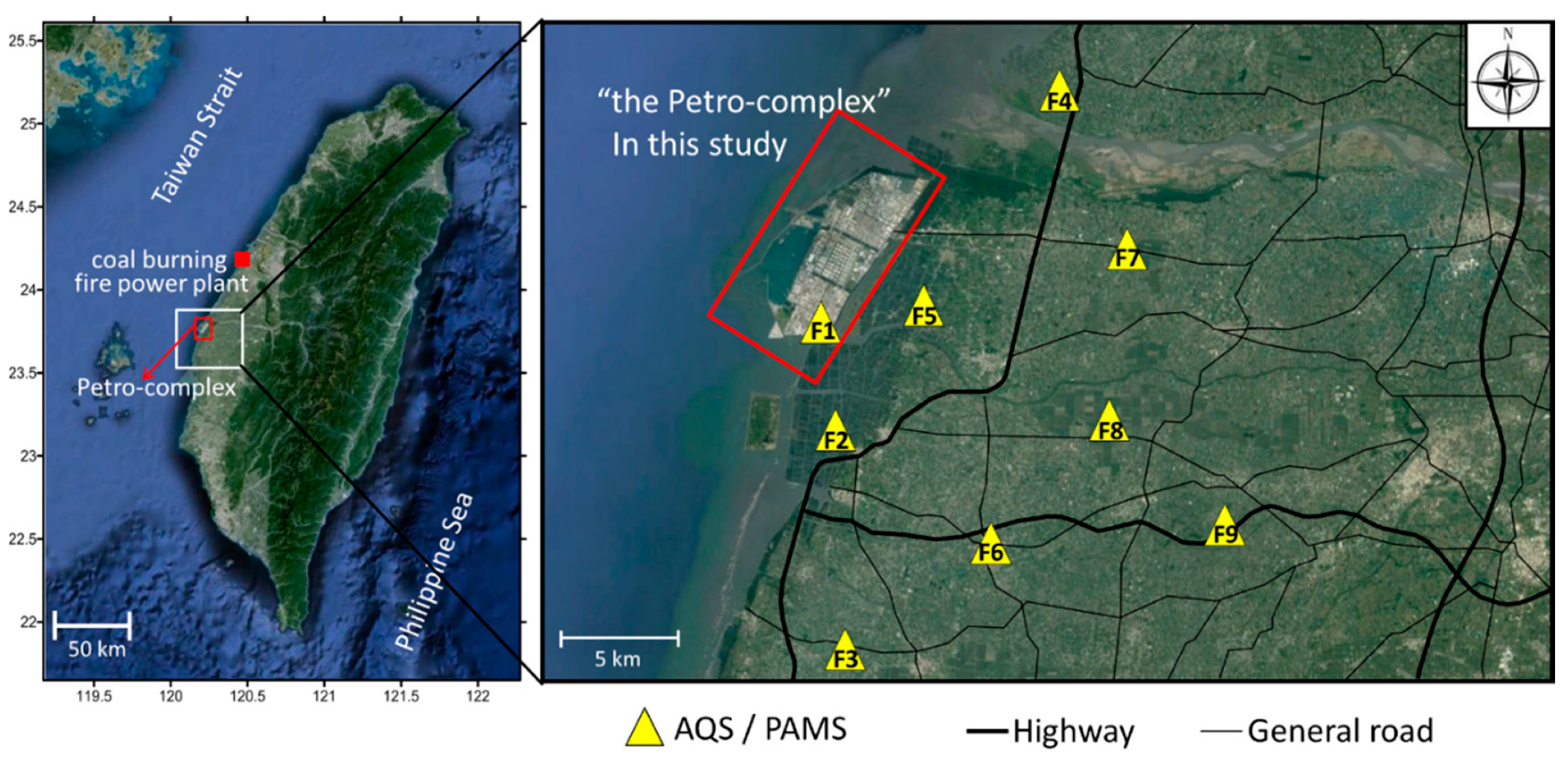
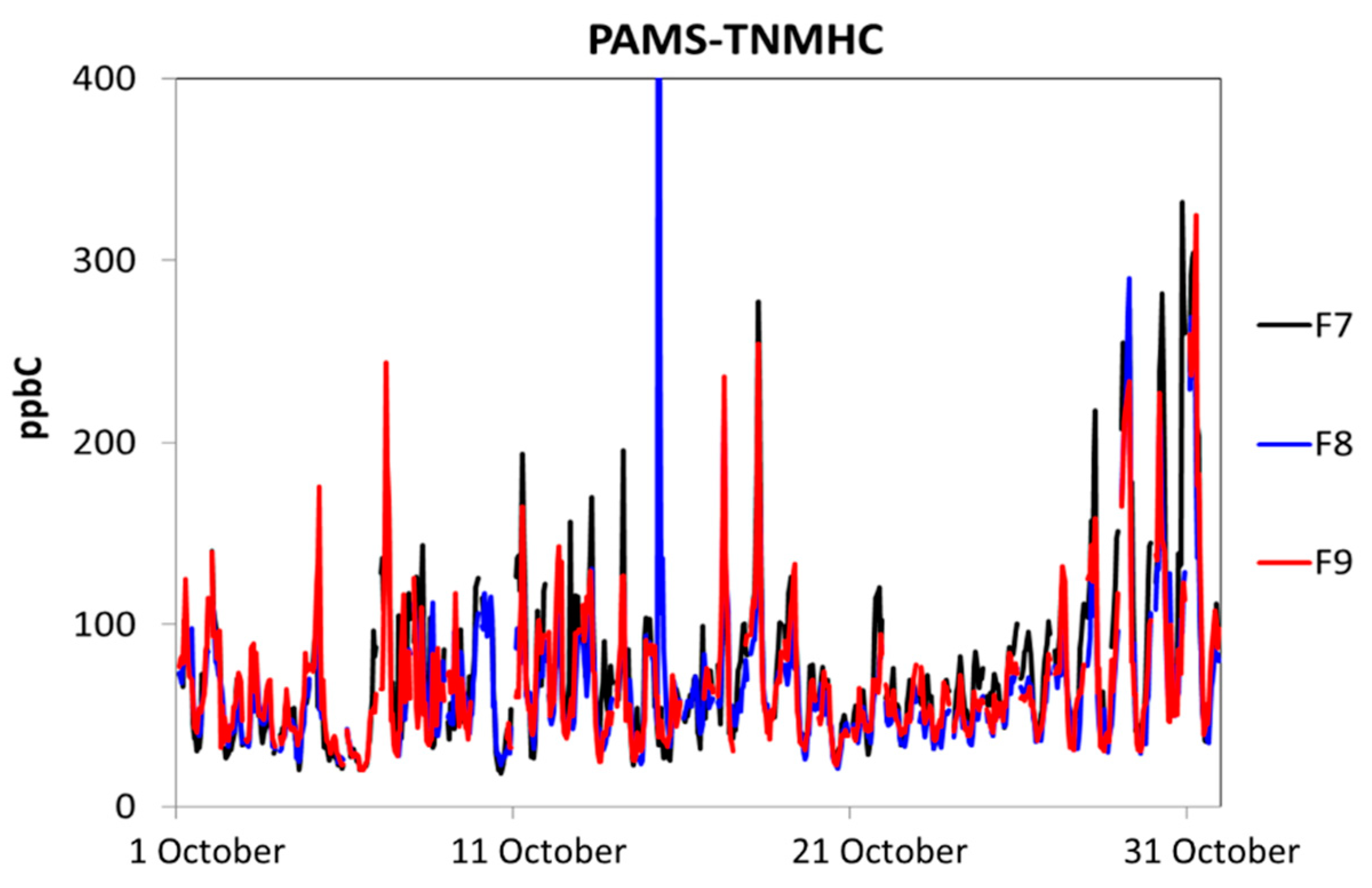
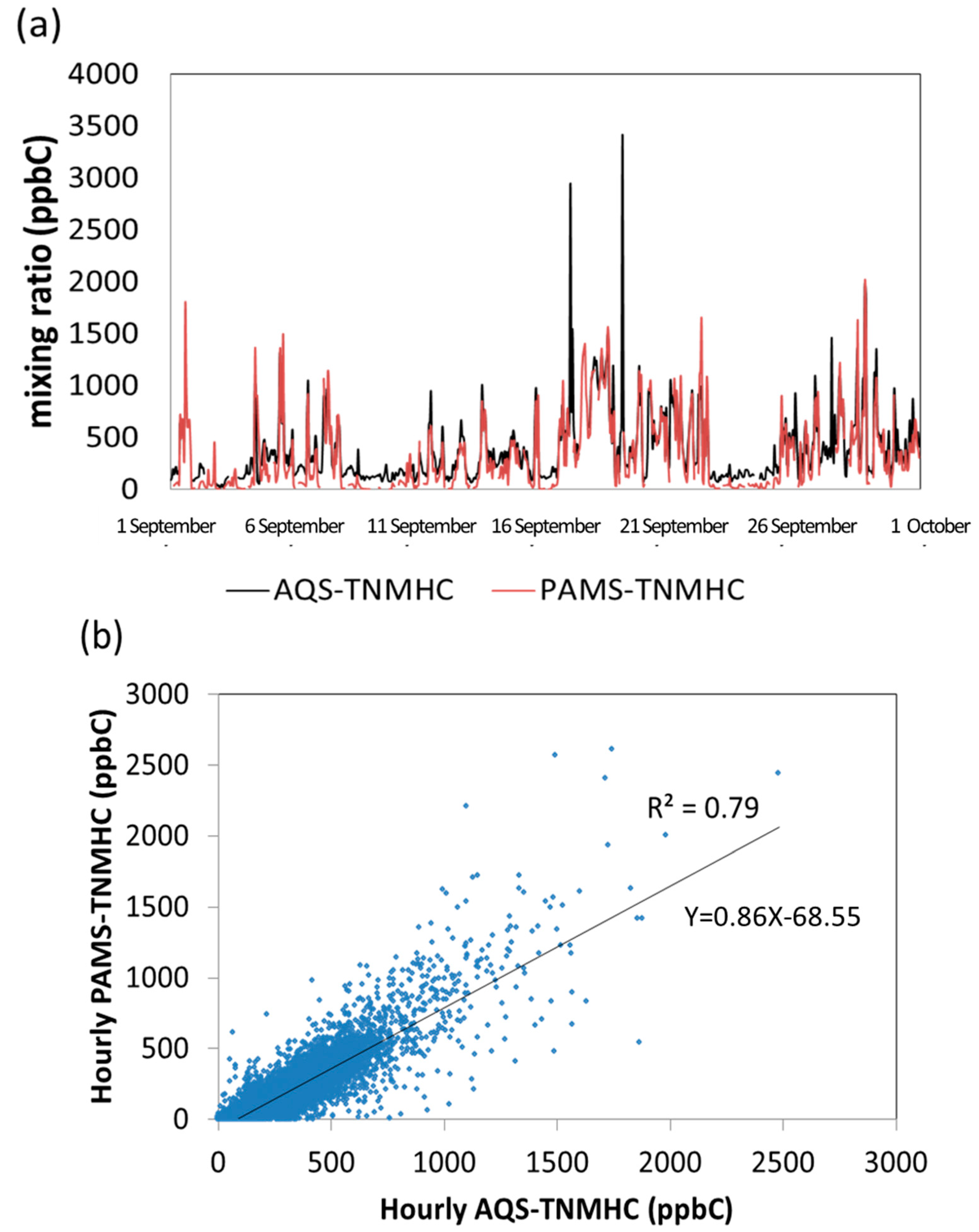
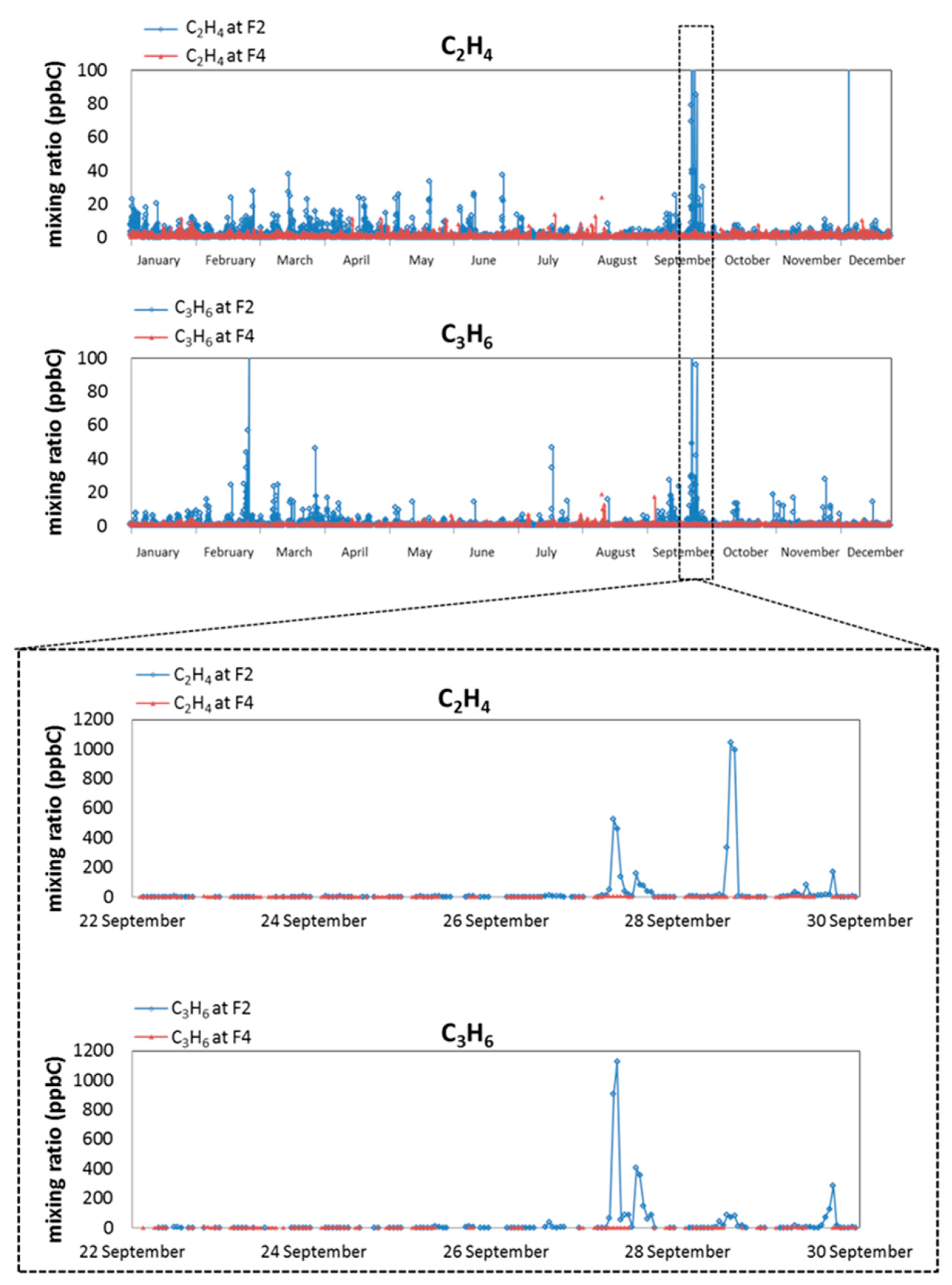
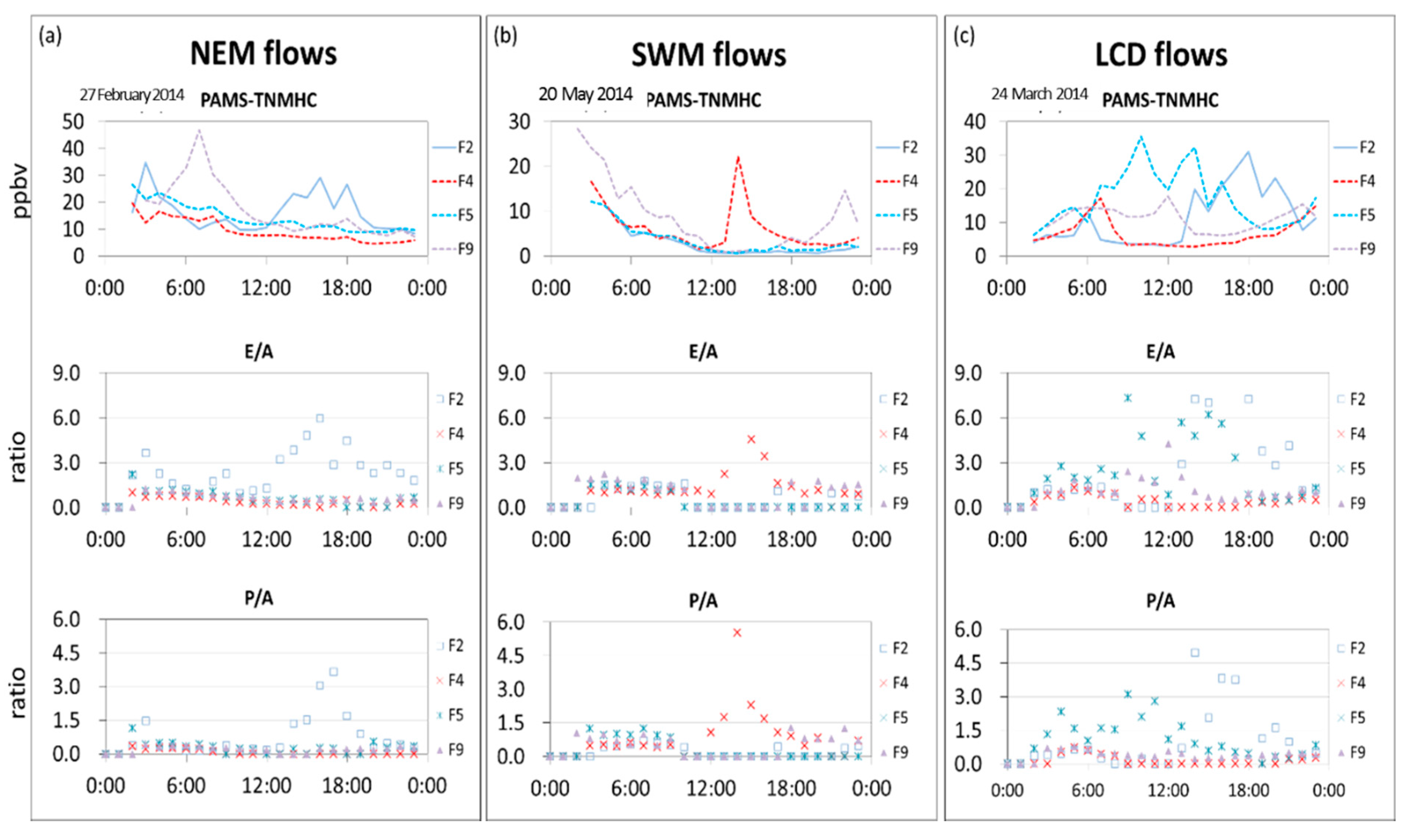
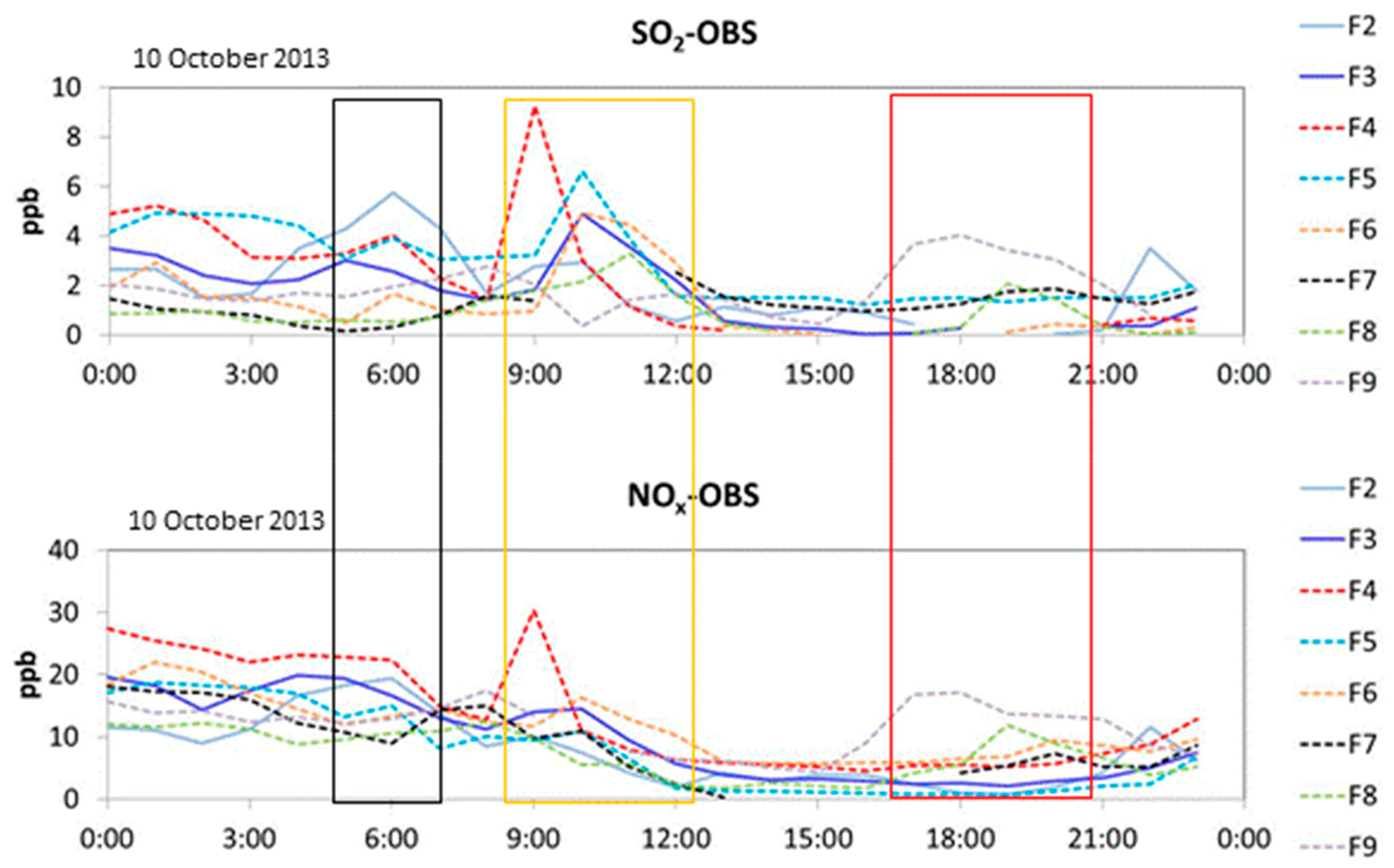
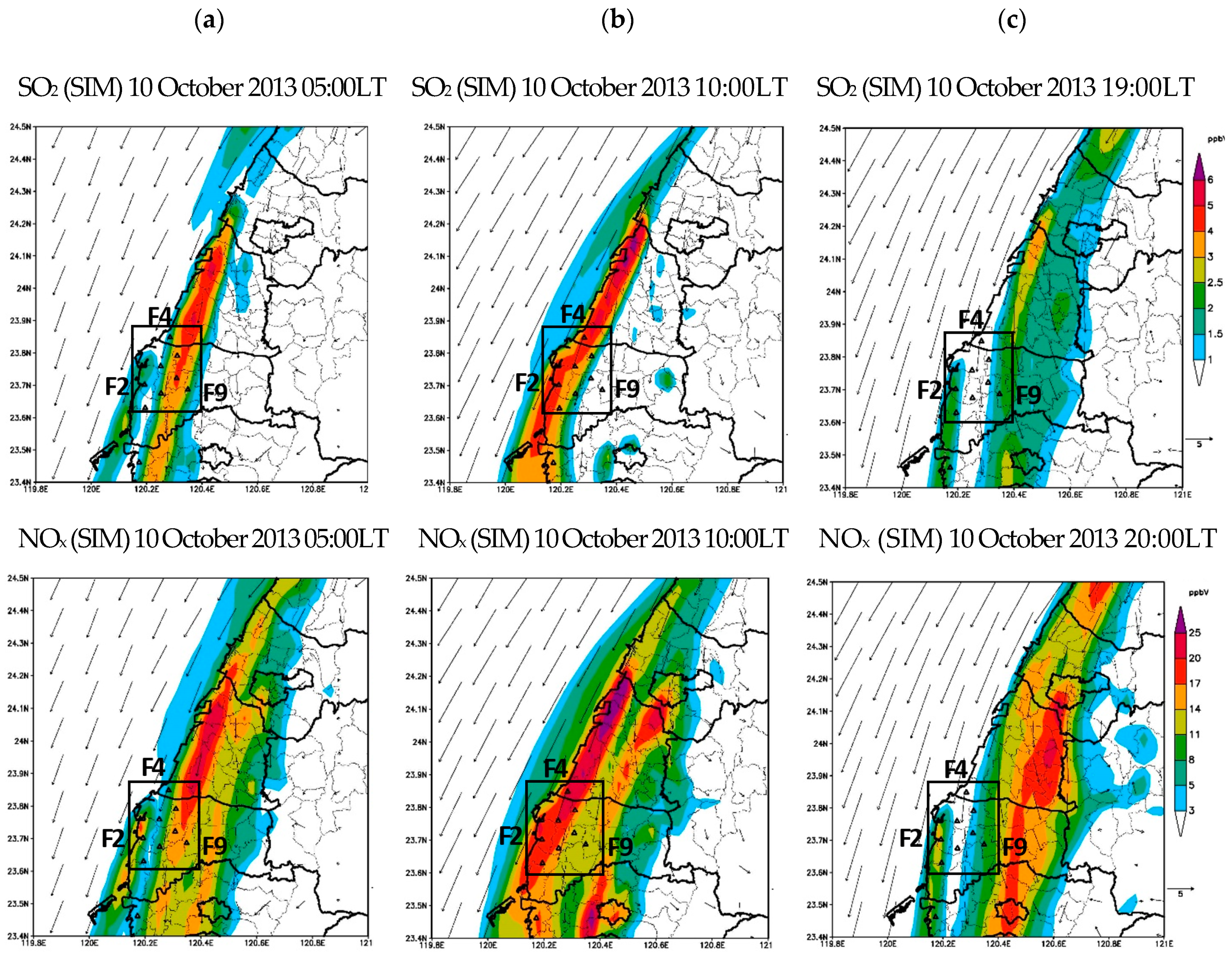
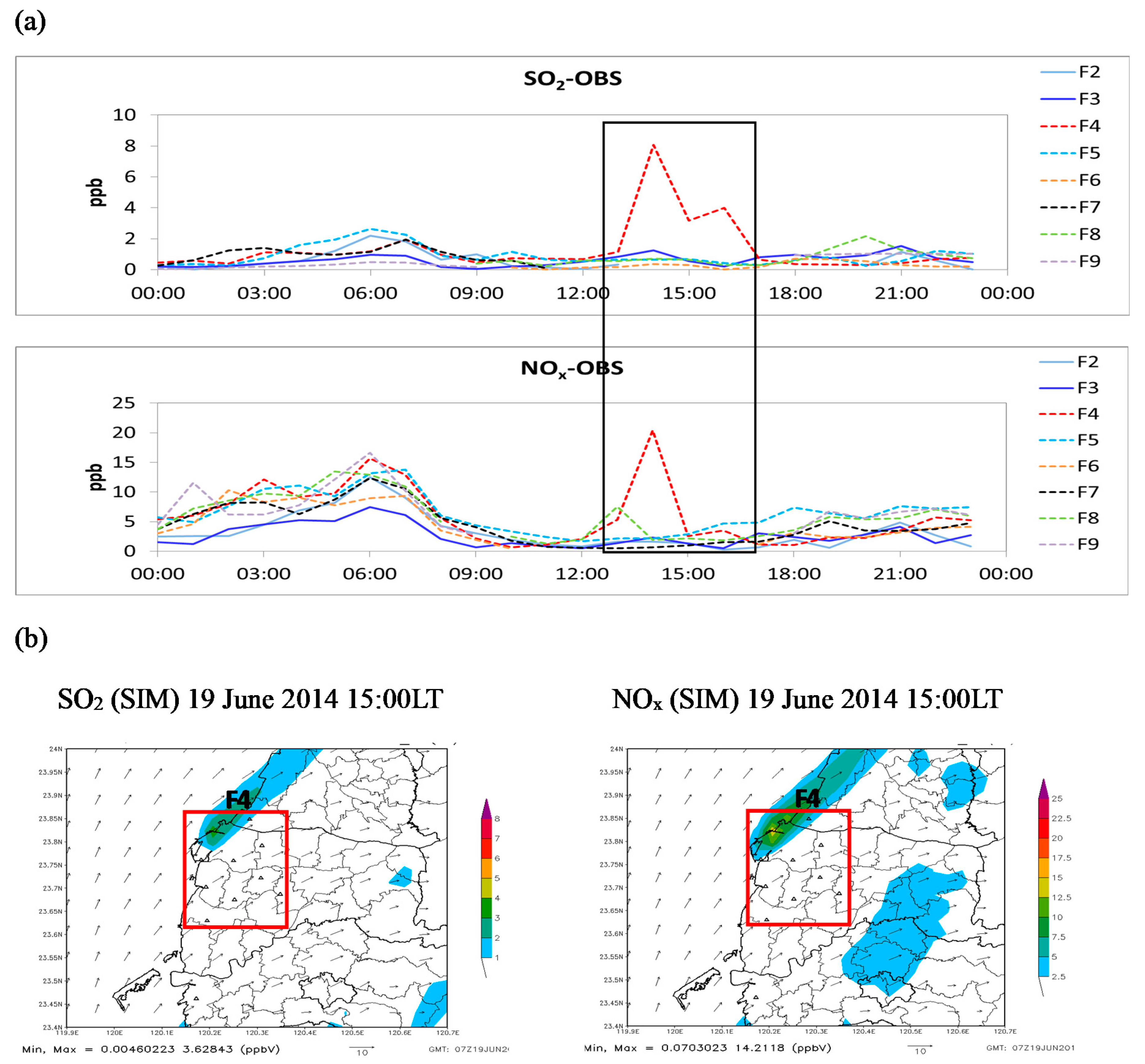
© 2020 by the authors. Licensee MDPI, Basel, Switzerland. This article is an open access article distributed under the terms and conditions of the Creative Commons Attribution (CC BY) license (http://creativecommons.org/licenses/by/4.0/).
Share and Cite
Tong, Y.-H.; Hung, P.-Y.; Su, Y.-C.; Chang, J.S.; Wang, J.-L. Exploring Effective Chemical Indicators for Petrochemical Emissions with Network Measurements Coupled with Model Simulations. Atmosphere 2020, 11, 439. https://doi.org/10.3390/atmos11050439
Tong Y-H, Hung P-Y, Su Y-C, Chang JS, Wang J-L. Exploring Effective Chemical Indicators for Petrochemical Emissions with Network Measurements Coupled with Model Simulations. Atmosphere. 2020; 11(5):439. https://doi.org/10.3390/atmos11050439
Chicago/Turabian StyleTong, Yu-Huei, Pei-Yu Hung, Yuan-Chang Su, Julius S. Chang, and Jia-Lin Wang. 2020. "Exploring Effective Chemical Indicators for Petrochemical Emissions with Network Measurements Coupled with Model Simulations" Atmosphere 11, no. 5: 439. https://doi.org/10.3390/atmos11050439
APA StyleTong, Y.-H., Hung, P.-Y., Su, Y.-C., Chang, J. S., & Wang, J.-L. (2020). Exploring Effective Chemical Indicators for Petrochemical Emissions with Network Measurements Coupled with Model Simulations. Atmosphere, 11(5), 439. https://doi.org/10.3390/atmos11050439




